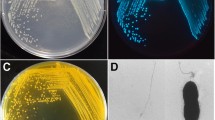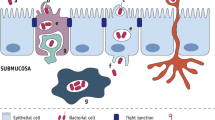Abstract
When bacteria are subjected to low acidic pHs of the gastric environment, they may enter the viable but nonculturable (VBNC) state of survival. In this state, bacteria cannot be cultured on solid media, still exhibit signs of metabolic activity (viability). In this study, the response of pathogenic Vibrio cholerae O1 and O139 to low pH-simulated environments of the human stomach was evaluated for their survival by culturability (plate count) and viability (flow cytometry—FC) assays. Bacteria were acid challenged with simulated gastric fluid (SGF) at pH 1.5, 2.5, 3.5 and 4.5 over a period of 180 min. Exposure to SGF up to 120 min increased acid tolerance of the Vibrios up to pH 3.5 with acid challenge occurring at pH 4.5. Bacteria were culturable from pH 2.5 to 4.5 up to 60 min SGF exposure. The stationary-phase cultures of Vibrio were able to survive SGF at all pHs in an ‘injured’ state with FC. This could possibly mean that the bacteria have entered the VBNC stage of survival. This is a worrying public health concern due to the fact that once favourable conditions arise (intestines), these Vibrios can change back to an infectious state and cause disease.




Similar content being viewed by others
References
Aertsen A, Michiels CW (2004) Stress and how bacteria cope with death and survival. Crit Rev Microbiol 30:263–273
Álvarez-Ordóñez A, Prieto M, Bernardo A, Hill C, López M (2012) The acid tolerance response of Salmonella spp. an adaptive strategy to survive in stressful environments prevailing in foods and the host. Food Res Int 45:482–492
Angelichio MJ, Merrell DS, Camilli A (2004) Spatio temporal analysis of acid adaptation-mediated Vibrio cholerae hyper infectivity. Infect Immun 72(4):2405–2407
Antolinos V, Esteban MD, Ros-Chumillas M, Huertas JP, Periago PM, Palop A, Fernández PS (2014) Assessment of the of acid shock effect on viability of Bacillus cereus and Bacillus weihenstephanensis using flow cytometry. Food Res Int 66:306–312
Arnold KW, Kaspar CW (1995) Starvation and stationary-phase-induced acid tolerance in Escherichia coli O157:H7. Appl Environ Microbiol 61:2037–2039
Barcina I, Arana I (2009) The viable but nonculturable phenotype: a crossroads in the life-cycle of non-differentiating bacteria. Rev Environ Sci Biotechnol 8:245–255
Bergholz TM, Whitman TS (2007) Variation in acid resistance among enterohaemorrhagic Escherichia coli in a simulated gastric environment. J Appl Microbiol 102(2):352–362
Booth IR, Cash P, O’Byrne C (2002) Sensing and adapting to acid stress. A Van Leeuw 81(1–4):33–42
Bore E, Langsrud S, Langsrud Ø, Rode TM, Holck A (2007) Acid-shock responses in Staphylococcus aureus investigated by global gene expression analysis. Microbiol 153(7):2289–2303
Camilleri M, Colemont LJ, Phillips SF, Brown ML, Thomforde GM, Chapman N, Zinsmeister AR (1989) Human gastric emptying and colonic filling of solids characterised by a new method. Am J Physiol Gastr L 257:G284–G290
Castellani F, Ghidini V, Tafi MC, Boaretti M, Lleo MM (2013) Fate of pathogenic bacteria in microcosms mimicking human body sites. Microb Ecol 66(1):224–231
Chaiyanan S, Chaiyanan S, Huq A, Maugel T, Colwell RR (2001) Viability of the nonculturable Vibrio cholerae O1 and O139. Syst Appl Microbiol 24:331–341
Chakraborty S, Mukhopadhyay AK, Bhadra RK, Ghosh AN, Mitra R, Shimada T, Yamasaki S, Faruque SM, Takeda Y, Colwell RR, Nair GB (2000) Virulence genes in environmental strains of Vibrio cholerae. Appl Environ Microbiol 66:4022–4028
Coldewey SM, Hartmann M, Schmidt DS, Engelking U, Ukena SN, Gunzer F (2007) Impact of the rpoS genotype for acid resistance patterns of pathogenic and probiotic Escherichia coli. BMC Microbiol 7:21
Colwell RR (1996) Global climate and infectious disease: the cholera paradigm. Science 274:2025–2031
Colwell RR, Brayton P, Grimes DJ, Roszak DB, Huq SA, Palmer LM (1985) Viable but non-culturable Vibrio cholerae and related pathogens in the environment: implications for release of genetically engineered microorganisms. Biotechnology 3:817–20
Colwell RR, Brayton P, Henrington D, Tall BD, Huq A, Levine MM (1996) Viable but nonculturable Vibrio cholerae O1 revert to a culturable state in the human intestine. World J Microb Biotechnol 12:28–31
Criscitiello MF, Dickman MB, Samuel JE, de Figueiredo P (2013) Tripping on acid: trans-kingdom perspectives on biological acids in immunity and pathogenesis. PLoS Pathog 9(7), e1003402. doi:10.1371/journal.ppat.1003402
Dodd CER, Richards PJ, Aldsworth TG (2007) Suicide through stress: a bacterial response to sub-lethal injury in the food environment. Int J Food Microbiol 120:46–50
Dodd CER, Sharman RL, Bloomfield SF, Booth IR, Stewart GSAB (1997) Inimical processes: bacterial self-destruction and sub-lethal injury. Trends Food Sci Tech 8:238–241
Dressman JB, Beraradi R, Dermentzglou LC, Russel TL, Schmaltz SP, Barnett JL, Jarvenpa KM (1990) Upper gastrointestinal pH in young, healthy men and women. Pharm Res 7(7):756–761
Farthing FB, Rodriguez SB, Thornton RJ (2007) Flow cytometric analysis of Saccharomyces cerevisiae populations in high-sugar Chardonnay fermentations. J Sci Food Agric 87:527–533
Faruque SM, Nair GB (2008) (Eds) (2008) Vibrio cholerae: genomics and molecular biology. Horizon Scientific Press, United Kingdom
Khan MM, Pyle BH, Camper AK (2010) Specific and rapid enumeration of viable but nonculturable and viable-culturable gram-negative bacteria by using flow cytometry. Appl Environ Microbiol 76(15):5088–5096
Kondo K, Takade A, Amako K (1994) Morphology of the viable but nonculturable Vibrio cholerae as determined by the freeze exaction technique. FEMS Microbiol Lett 123:179–184
Koseki S, Mizuno Y, Sotome I (2011) Modelling of pathogen survival during simulated gastric digestion. Appl Environ Microbiol 77(3):1021–1032
Leal NC, de Araújo Figueiroa ACT, Cavalcanti VO, da Silva SC, Leal-Balbino TC, de Almeida AMP, Hofer E (2008) Characterization of Vibrio cholerae isolated from the aquatic basins of the state of Pernambuco, Brazil. Trans R Soc Trop Med Hyg 102:272–276
Li L, Mendis N, Trigui H, Oliver JD, Faucher SP (2014) The importance of the viable but non-culturable state in human bacterial pathogens. Front Microbiol 5:258. doi:10.3389/fmicb.2014.00258
Lin J, Smith MP, Chapin KC, Hyung SB, Bennett GN, Foster JW (1996) Mechanisms of acid resistance in enterohemorrhagic Escherichia coli. Appl Environ Microbiol 62(9):3094–3100
McDougald D, Rice S, Weichart D, Kjelleberg S (1998) Nonculturability: adaptation or debilitation? FEMS Microbiol Ecol 25:1–9
Merrell DS, Camilli A (1999) The cadA gene of Vibrio cholerae is induced during infection and plays a role in acid tolerance. Mol Microbiol 34:836–849
Merrell DS, Camilli A (2002) Acid tolerance of gastrointestinal pathogens. Curr Opin Microbiol 5:51–55
Mukamolova GV, Kaprelyants AS, Kell DB (1995) Secretion of an antibacterial factor during resuscitation of dormant cells in Micrococcus luteus cultures held in an extended stationary phase. A Van Leeuw 67(3):289–295
Nebe-von Caron G, Stephens PJ, Badley RA (1998) Assessment of bacterial viability status by flow cytometry and single cell sorting. J Appl Microbiol 84:988–998
Nebe-von Caron G, Stephens PJ, Hewitt CJ, Powell JR, Badley RA (2000) Analysis of bacterial function by multi-colour fluorescence flow cytometry and single cell sorting. J Microbiol Methods 42:97–114
Nocker A, Richter-Heitmann T, Montijn R, Schuren F, Kort R (2010) Discrimination between live and dead cells in bacterial communities from environmental water samples analyzed by 454 pyrosequencing. Int Microbiol 13:59–65
Oliver JD (2005) The viable but non culturable state in bacteria. J Microbiol 43(1):93–100
Pieretti B, Masucci A, Moretti M (2012) Applications of flow cytometry to clinical microbiology. In: Ingrid S (ed) Clinical flow cytometry - Emerging applications, 978-953-51st edn., pp 0575–6, InTech, Available from: http://www.intechopen.com/books/clinical-flow-cytometry-emergingapplications/applications-of-flow-cytometry-to-clinical-microbiology
Porter J, Edwards C, Pickup RW (1995) Rapid assessment of physiological status in Escherichia coli using fluorescent probes. J Appl Bacteriol 79(4):399–408
Rivera ING, Chun J, Huq A, Sack RB, Colwell RR (2001) Genotypes associated with virulence in environmental isolates of Vibrio cholerae. Appl Environ Microbiol 67:2421–2429
Rowbury RJ (1999) Acid tolerance induced by metabolites and secreted proteins, and how tolerance can be counteracted. Bacterial Responses Ph 221:93–111
Sachs G, Scott D, Weeks D, Melchers K (2000) Gastric habitation by Helicobacter pylori: insights into acid adaptation. Trends Pharmacol Sci 413–416
Senoh M, Ghosh-Banerjee J, Ramamurthy T, Hamabata T, Kurakawa T, Takeda M, Colwell RR, Nair GB, Takeda Y (2010) Conversion of viable but nonculturable Vibrio cholerae to the culturable state by co-culture with eukaryotic cells. Microbiol Immunol 54:502–507
Spagnuolo AM, Di Rita V, Kirschner D (2011) A model for Vibrio cholerae colonization of the human intestine. J Theor Biol 289:247–258
Tamplin ML (2005) Inactivation of Escherichia coli O157:H7 in simulated human gastric fluid. Appl Environ Microbiol 71:320–325
Thompson FL, Iida T, Swings J (2003) Biodiversity of Vibrios. Microbiol Mol Biol R 68:403–431
Waterman SR, Small PL (1998) Acid-sensitive enteric pathogens are protected from killing under extremely acidic conditions of pH 2.5 when they are inoculated onto certain solid food sources. Appl Environ Microbiol 64:3882–3886
World Health Organization (WHO) (2003) Relationships between common water bacteria and pathogens in drinking-water. In: Bartram J, Cotruvo J, Exner M, Fricker C, Glasmacher A (eds) Heterotrophic plate counts and drinking-water safety. Published by IWA Publishing, London
Yuk H, Jo S, Seo H, Park S, Lee S (2008) Effect of storage in juice with or without pulp and/or calcium lactate on the subsequent survival of Escherichia coli O157:H7 in simulated gastric fluid. Int J Food Microbiol 123:198–203
Author information
Authors and Affiliations
Corresponding author
Ethics declarations
Funding
This study in part was funded by the National Research Foundation (ZA) (Grant Number: 85117) and the University of Johannesburg.
Conflict of interest
The authors declare that they have no competing interests.
Ethical approval
This article does not contain any studies with human participants or animals performed by any of the authors.
Rights and permissions
About this article
Cite this article
Singh, A., Barnard, T.G. Surviving the acid barrier: responses of pathogenic Vibrio cholerae to simulated gastric fluid. Appl Microbiol Biotechnol 100, 815–824 (2016). https://doi.org/10.1007/s00253-015-7067-2
Received:
Revised:
Accepted:
Published:
Issue Date:
DOI: https://doi.org/10.1007/s00253-015-7067-2




